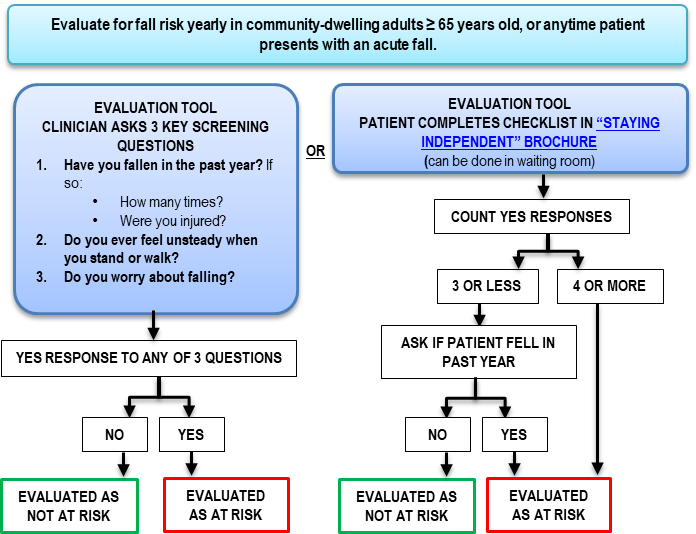Dementia Fall Risk Can Be Fun For Everyone
Dementia Fall Risk Can Be Fun For Everyone
Blog Article
The Dementia Fall Risk Statements
Table of ContentsDementia Fall Risk Things To Know Before You BuyExamine This Report on Dementia Fall RiskDementia Fall Risk for BeginnersDementia Fall Risk Can Be Fun For Everyone
An autumn risk analysis checks to see exactly how likely it is that you will certainly fall. The evaluation generally includes: This consists of a collection of inquiries about your total wellness and if you've had previous falls or problems with equilibrium, standing, and/or strolling.Interventions are referrals that might decrease your threat of dropping. STEADI includes 3 actions: you for your danger of dropping for your risk variables that can be improved to try to stop drops (for instance, equilibrium troubles, impaired vision) to lower your danger of dropping by utilizing effective methods (for example, supplying education and resources), you may be asked a number of concerns including: Have you fallen in the past year? Are you fretted concerning falling?
If it takes you 12 secs or more, it may suggest you are at greater risk for a fall. This test checks toughness and balance.
The positions will certainly obtain tougher as you go. Stand with your feet side-by-side. Move one foot halfway onward, so the instep is touching the big toe of your various other foot. Move one foot completely before the various other, so the toes are touching the heel of your other foot.
Some Known Questions About Dementia Fall Risk.
The majority of falls take place as a result of several contributing elements; as a result, taking care of the threat of falling starts with determining the elements that add to drop risk - Dementia Fall Risk. Several of the most pertinent risk variables consist of: History of previous fallsChronic clinical conditionsAcute illnessImpaired gait and balance, reduced extremity weaknessCognitive impairmentChanges in visionCertain high-risk medications and polypharmacyEnvironmental factors can likewise raise the risk for drops, including: Poor lightingUneven or damaged flooringWet or unsafe floorsMissing or damaged hand rails and get hold of barsDamaged or poorly fitted devices, such as beds, mobility devices, or walkersImproper use assistive devicesInadequate supervision of the people staying in the NF, consisting of those that exhibit aggressive behaviorsA successful autumn threat administration program needs a comprehensive clinical analysis, with input from all members of the interdisciplinary team

The care strategy ought to additionally include treatments that are system-based, such as those that promote a risk-free atmosphere (suitable lighting, handrails, get bars, and so on). The performance of the treatments ought to be evaluated periodically, and the care plan revised as needed to reflect modifications in the loss risk analysis. Implementing an autumn danger management system utilizing evidence-based finest method can reduce the frequency of falls in the NF, while limiting the potential for fall-related injuries.
9 Easy Facts About Dementia Fall Risk Described
The AGS/BGS standard suggests screening all go to my blog adults matured 65 years and older for fall danger yearly. This testing consists of asking patients whether they have fallen 2 or even more times in the past year or looked for clinical focus for a fall, or, if they have not fallen, whether they feel unsteady when walking.
Individuals that have actually fallen as soon as without injury must have their balance and gait examined; those with gait or balance problems ought to receive additional analysis. A history of 1 fall here without injury and without stride or equilibrium issues does not call for further analysis beyond ongoing yearly autumn danger testing. Dementia Fall Risk. An autumn danger evaluation is needed as part of the Welcome to Medicare examination

The Greatest Guide To Dementia Fall Risk
Recording a falls history is one of the high quality indicators for fall avoidance and management. copyright drugs in specific are independent forecasters of drops.
Postural hypotension can usually be eased by lowering the dose of blood pressurelowering medicines and/or quiting medicines that have orthostatic hypotension as a negative effects. Use above-the-knee support hose pipe and copulating the head home of the bed raised might additionally minimize postural decreases in blood pressure. The preferred elements of a fall-focused physical exam are received Box 1.

A Pull time higher than or equal to 12 seconds suggests high fall danger. Being unable to stand up from a chair of knee height without making use of one's arms indicates increased autumn threat.
Report this page